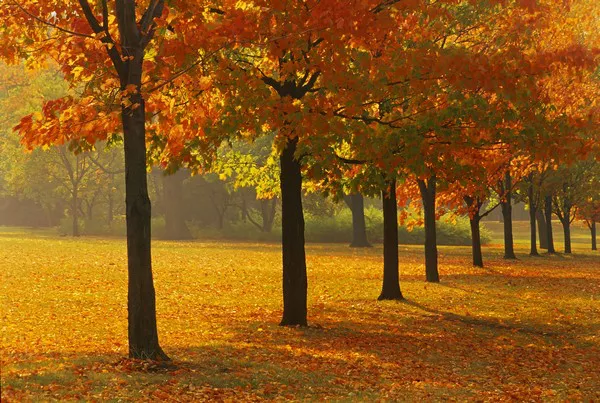Maple trees, members of the Acer genus, are iconic symbols of fall foliage and have earned their place as beloved landscape trees. With their distinctive lobed leaves and vibrant autumn hues, maples are valued for their ornamental beauty and versatility. In this comprehensive exploration, we delve into the world of maples, unveiling the ten most common species that grace landscapes around the world. From urban parks to rural woodlands, these maples have become fixtures in diverse ecosystems, offering shade, visual appeal, and even syrup. Join us as we embark on a journey through the 10 most common maple trees, appreciating the diversity and beauty they bring to the natural world.
10 Most Common Maple Trees
1. Sugar Maple (Acer saccharum)
Renowned for its brilliant fall foliage and its role as the primary source of maple syrup, the Sugar Maple is a quintessential North American species. This deciduous tree is native to eastern North America, stretching from Canada down to the United States. Sugar Maples are identifiable by their distinctively shaped leaves with five lobes and serrated edges. In autumn, their foliage transforms into a dazzling array of red, orange, and yellow hues, making them a centerpiece in fall landscapes.
2. Red Maple (Acer rubrum)
Versatile and adaptable, the Red Maple is one of the most widespread maple species in North America. Its native range spans from eastern Canada to Florida and westward to Texas. Red Maples are known for their vibrant red flowers in spring, red stems, and brilliant red fall foliage. With a wide range of soil and moisture tolerances, these trees thrive in various environments, from wetlands to upland forests, making them a common sight in diverse landscapes.
3. Norway Maple (Acer platanoides)
Originally from Europe, the Norway Maple has been widely planted as an ornamental tree in urban and suburban areas. Recognizable by its broad, palmate leaves with five to seven lobes, the Norway Maple comes in various cultivars with different leaf colors, including green, red, and variegated. Despite its popularity, it can be considered invasive in some regions due to its ability to outcompete native vegetation.
4. Silver Maple (Acer saccharinum)
Known for its rapid growth and distinctive silvery undersides of its leaves, the Silver Maple is a common sight in urban settings and along waterways. Native to North America, its natural range extends from eastern Canada to Florida and westward to Texas. Silver Maples are characterized by their deeply lobed leaves, silver-gray bark, and red flowers in early spring. While prized for its quick growth, the wood of the Silver Maple is considered relatively soft and is susceptible to breakage in storms.
5. Japanese Maple (Acer palmatum)
Celebrated for its delicate, finely dissected leaves and elegant form, the Japanese Maple is a prized ornamental tree in gardens around the world. Native to Japan, Korea, and China, this deciduous tree comes in a variety of cultivars, each with its unique leaf shape, size, and color. Japanese Maples are often chosen for their aesthetic appeal, adding a touch of grace and beauty to landscapes, whether in traditional Japanese gardens or modern urban spaces.
6. Boxelder (Acer negundo)
Found across North America, the Boxelder, also known as the Manitoba Maple, is a fast-growing and adaptable maple species. Recognizable by its compound leaves with three to five leaflets, the Boxelder is often considered a weedy tree. It is tolerant of a wide range of environmental conditions and is often found along riverbanks, in disturbed areas, and in urban landscapes. While not as celebrated as some other maples, the Boxelder plays a role in diverse ecosystems.
7. Bigleaf Maple (Acer macrophyllum)
Native to the west coast of North America, the Bigleaf Maple is characterized by its large, broad leaves and impressive size. Growing in the Pacific Northwest, from southern Alaska to California, these deciduous trees are well-suited to the region’s mild and wet climate. Bigleaf Maples are valued for their shade and are ecologically significant, providing habitat for various wildlife species. Their leaves can reach sizes of up to 12 inches in diameter.
8. Sycamore Maple (Acer pseudoplatanus)
Native to central and southern Europe, the Sycamore Maple is recognized for its broad, palmate leaves and distinctive bark. Widely planted as an ornamental tree, it has naturalized in some areas outside its native range. Sycamore Maples are known for their tolerance to urban conditions and are commonly found along streets and in parks. They produce winged seeds, or samaras, that spin as they fall, adding an element of whimsy to their reproductive strategy.
9. Amur Maple (Acer ginnala)
Hailing from East Asia, the Amur Maple is a small deciduous tree known for its vibrant fall foliage and compact size. Adaptable and hardy, it is often used as an ornamental tree in gardens and landscapes. The Amur Maple produces winged seeds and is characterized by its trifoliate leaves, which consist of three leaflets. Its autumn colors range from orange to red, adding a burst of color to fall landscapes.
10. Field Maple (Acer campestre)
Native to Europe and western Asia, the Field Maple is a deciduous tree that thrives in a variety of habitats, from woodlands to hedgerows. Known for its compact, rounded crown and deeply lobed leaves, the Field Maple is often used as a street tree and in urban landscaping. In addition to its ornamental value, it provides habitat for birds and insects, contributing to local biodiversity.
See Also:10 MOST BEAUTIFUL RHODODENDRONS
Conclusion
As we traverse the diverse landscapes of the world, the presence of maple trees adds layers of beauty and ecological significance. From the iconic Sugar Maple contributing to the maple syrup industry to the elegant Japanese Maple gracing gardens, each species brings its unique charm. The ten most common maple trees showcased here not only symbolize the changing seasons with their vibrant fall foliage but also play crucial roles in supporting ecosystems and enhancing the visual appeal of our surroundings. As we appreciate the diversity of maples, we gain a deeper understanding of their ecological importance and the cultural significance they hold in various regions around the globe.
You Might Be Interested In:
























